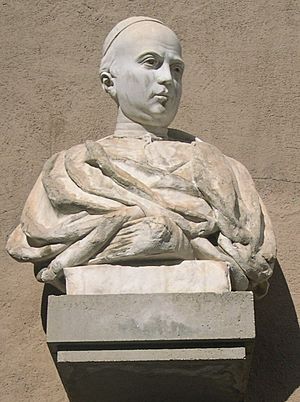Antonio Comellas y Cluet facts for kids
Antonio Comellas y Cluet (born January 16, 1832, in Berga; died June 3, 1884, in Berga) was an important Spanish philosopher. A philosopher is someone who studies big questions about life, knowledge, values, and how we should live.
Contents
Early Life and Studies
Antonio Comellas grew up in Berga, a town in Spain. He went to school in Vic where he studied philosophy and theology. Theology is the study of religious faith and God.
Later, he joined the diocesan seminary in Solsona, Lleida. A seminary is a special school that trains people to become priests.
Becoming a Priest and Teacher
Antonio Comellas became a priest on May 17, 1856. After that, he continued to teach Latin at Solsona. Latin is an old language that was used a lot in scholarly and religious texts. He taught there until 1862.
In 1862, he became a professor of theology. This meant he taught about religious ideas and beliefs to students.
His Writings and Ideas
During his time as a professor, Antonio Comellas wrote two short books, also called pamphlets. One was a speech he gave in 1866. In this speech, he shared new ideas about religious concepts.
The second pamphlet was a translation of a book by Reginald Baumstark. This book was about a Protestant person's thoughts on joining the Catholic Church. Comellas added his own notes and an introduction to the translation.
Focusing on Philosophy
In 1871, Antonio Comellas decided to leave his teaching job. He wanted to spend more time on his own philosophical studies and writing. So, he moved back to his hometown of Berga.
Before 1880, he published another important book. It was called Demostración de la armonía entre la religión católica y la ciencia. This book aimed to show that religious faith and science can agree with each other. He wrote it to disagree with ideas from another book, Conflict Between Science and Religion, by John William Draper.
His Main Philosophical Work
In 1883, Comellas wrote his most important philosophical book. It was called Introducción á la filosofía, ó sea doctrina, sobre la dirección al ideal de la ciencia. This book was about how to think about science and knowledge.
His biographer, Gómez Izquierdo, said that Comellas was a unique thinker. He explored many different philosophical ideas from Europe during his time. He was interested in learning new things on his own.
Some people see Antonio Comellas as one of the early thinkers who helped start a new way of studying old philosophical ideas in Spain. This new way of thinking is sometimes called Neo-Scholasticism.
See also
 In Spanish: Antonio Comellas y Cluet para niños
In Spanish: Antonio Comellas y Cluet para niños


